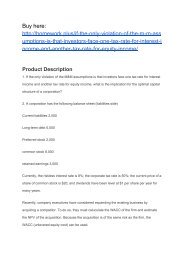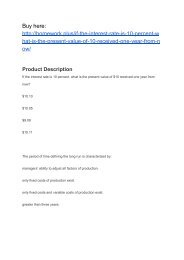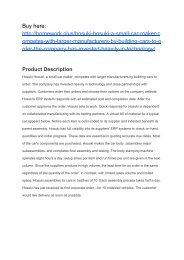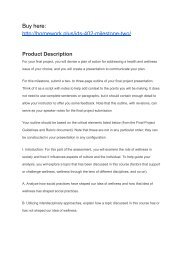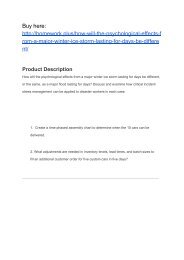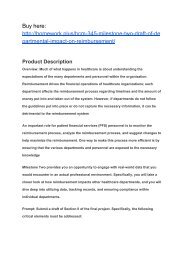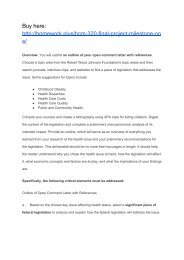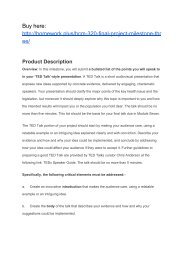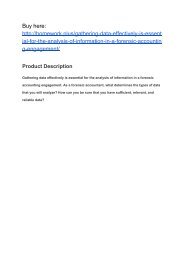Client Profile: Steve Rogers
Client Profile: Steve Rogers
Client Profile: Steve Rogers
You also want an ePaper? Increase the reach of your titles
YUMPU automatically turns print PDFs into web optimized ePapers that Google loves.
Buy here:<br />
http://homework.plus/client-profile-steve-rogers/<br />
Product Description<br />
1. <strong>Client</strong> <strong>Profile</strong>: <strong>Steve</strong> <strong>Rogers</strong><br />
2<br />
Mal<br />
60<br />
6<br />
178<br />
11<br />
7<br />
e<br />
bpm<br />
'<br />
pounds<br />
%<br />
<strong>Steve</strong> is an avid runner and has been quite slim his whole life. He runs moderate- to<br />
long-distances 3 or 4 days per week. Running is his only physical activity. <strong>Steve</strong> has never<br />
been interested in resistance training because it is not his strong suit. <strong>Steve</strong> recently decided<br />
that he is tired of being skinny. He would like to put on some size and muscle before he<br />
travels back to his hometown for a good friend's wedding in 12 weeks.<br />
<strong>Client</strong> Calculations<br />
●<br />
●<br />
Using the information above, calculate the client's BMR and DCR<br />
Calculate the client's Target Heart Rate using the Karvonen formula (you will<br />
determine the appropriate target heart rate for this client given the information<br />
gathered in the initial assessment and evaluation)<br />
Include the following in your case study submission:<br />
●<br />
A description of your professional responsibilities as discussed in the stages of the<br />
drawing-in process (Unit 12)<br />
●<br />
Discussion of any fitness tests, methods of evaluation, and data collection used to<br />
assess and evaluate the client's needs.
●<br />
Explanation for your recommendations and any specific conditions presented by<br />
your client that are found in the evaluation. (Be sure to reference course concepts<br />
when discussing rationale for your recommendations.)<br />
●<br />
A detailed 12-week comprehensive and periodized training program including<br />
specific exercises, sets, repetitions, suggested rest times, etc. Use an integrated<br />
approach in your program recommendations.<br />
●<br />
Specific and detailed nutritional strategies with explanation as to how they will<br />
assist the client in meeting energy needs throughout the training program and<br />
achieving intended goal(s).<br />
Keep in mind that a client should be able to take your program and put it into practice without<br />
having to contact you to clarify what you intended by your recommendations, or to explain<br />
parts of your program.<br />
Include an explanation for WHY you listed and recommended what you did. Reference the<br />
concepts and theories covered in the course. Be sure to address why the program and<br />
exercises recommended are appropriate for the specific client given client history, current<br />
abilities, and intended goal(s). For example: if you are developing a program for a beginner<br />
client without any resistance training experience, explain how your program addresses the<br />
lack of experience, initial need for foundational development, process by which you would<br />
safely progress the client, etc. Tying your program to course concepts is a critical component<br />
of your case study.<br />
2. <strong>Client</strong> <strong>Profile</strong>: Selina Kyle<br />
3<br />
Femal<br />
70<br />
5'7<br />
159<br />
33<br />
1<br />
e<br />
bpm<br />
"<br />
pounds<br />
%
Selina just had her first baby a couple months ago and is determined to shed exess<br />
pregnancy pounds before Summer. Selina has very limited exercise experience. She did not<br />
play high school or college sports. Prior to having her first child, she did like to hike, go out<br />
dancing, and take the occasional yoga class. She is eager to start a program to lose the<br />
baby weight. She can dedicate 3 or 4 days per week to exercise and is willing to sign on for<br />
12 weeks to start.<br />
<strong>Client</strong> Calculations<br />
●<br />
●<br />
Using the information above, calculate the client's BMR and DCR<br />
Calculate the client's Target Heart Rate using the Karvonen formula (you will<br />
determine the appropriate target heart rate for this client given the information<br />
gathered in the initial assessment and evaluation)<br />
Include the following in your case study submission:<br />
●<br />
A description of your professional responsibilities as discussed in the stages of the<br />
drawing-in process (Unit 12)<br />
●<br />
Discussion of any fitness tests, methods of evaluation, and data collection used to<br />
assess and evaluate the client's needs.<br />
●<br />
Explanation for your recommendations and any specific conditions presented by<br />
your client that are found in the evaluation. (Be sure to reference course concepts<br />
when discussing rationale for your recommendations.)<br />
●<br />
A detailed 12-week comprehensive and periodized training program including<br />
specific exercises, sets, repetitions, suggested rest times, etc. Use an integrated<br />
approach in your program recommendations.<br />
●<br />
Specific and detailed nutritional strategies with explanation as to how they will<br />
assist the client in meeting energy needs throughout the training program and<br />
achieving intended goal(s).
Keep in mind that a client should be able to take your program and put it into practice without<br />
having to contact you to clarify what you intended by your recommendations, or to explain<br />
parts of your program.<br />
Include an explanation for WHY you listed and recommended what you did. Reference the<br />
concepts and theories covered in the course. Be sure to address why the program and<br />
exercises recommended are appropriate for the specific client given client history, current<br />
abilities, and intended goal(s). For example: if you are developing a program for a beginner<br />
client without any resistance training experience, explain how your program addresses the<br />
lack of experience, initial need for foundational development, process by which you would<br />
safely progress the client, etc. Tying your program to course concepts is a critical component<br />
of your case study.<br />
●<br />
Personal jurisdiction. Define personal jurisdiction and explain how it applies to the<br />
facts of this case.<br />
●<br />
Subject matter jurisdiction. Define subject matter jurisdiction and explain how it<br />
applies to the facts of this case.<br />
●<br />
Minimum contacts. Define minimum contacts and explain how it applies to the<br />
facts of case.<br />
Apply the rules of jurisdiction to the facts of this case and determine what jurisdiction(s)<br />
would be appropriate for Margolin’s lawsuit against Funny Faceand Novelty Now,<br />
respectively. Consider federal court, state court, and long arm principles in your analysis.




